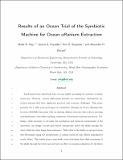| dc.contributor.author | Haji, Maha N. | |
| dc.contributor.author | Drysdale, Jessica A. | |
| dc.contributor.author | Haji, Maha Niametullah | |
| dc.contributor.author | Buesseler, Ken O. | |
| dc.contributor.author | Slocum, Alexander H. | |
| dc.date.accessioned | 2020-10-08T22:54:02Z | |
| dc.date.available | 2020-10-08T22:54:02Z | |
| dc.date.issued | 2019-01-16 | |
| dc.date.submitted | 2018-12 | |
| dc.identifier.issn | 0013-936X | |
| dc.identifier.issn | 1520-5851 | |
| dc.identifier.uri | https://hdl.handle.net/1721.1/127940 | |
| dc.description.abstract | Amidoxime-based adsorbents have become highly promising for seawater uranium extraction. However, current deployment schemes are stand-alone, intermittent operation systems that have significant practical and economic challenges. This paper presents two 1:10 scale prototypes of a Symbiotic Machine for Ocean uRanium Extraction (SMORE) which pairs with an existing offshore structure. This pairing reduces mooring and deployment costs while enabling continuous, autonomous uranium extraction. Utilizing a shell enclosure to decouple the mechanical and chemical requirements of the adsorbent, one design concept prototyped continuously moves the shells through the water while the other keeps them stationary. Water flow in the shells on each prototype was determined using the measurement of radium adsorbed by MnO 2 impregnated acrylic fibers contained within each enclosure. The results from a nine-week ocean trial show that while movement of the shells through the water may not have an effect on uranium adsorption by the fibers encased, it could help reduce biofouling if above a certain threshold speed (resulting in increased uptake), while also allowing for the incorporation of design elements to further mitigate biofouling such as bristle brushes and UV lamps. The trace metal uptake by the AI8 adsorbents in this trial also varied greatly from previous marine deployments, suggesting that uranium uptake may depend greatly upon the seawater concentrations of other elements such as vanadium and copper. The results from this study will be used to inform future work on the seawater uranium production cost from a full-scale SMORE system. | en_US |
| dc.description.sponsorship | U.S. Department of Energy Office of Nuclear Energy (Contracts DE-NE0008268 and DE-NE000731) | en_US |
| dc.language.iso | en | |
| dc.publisher | American Chemical Society (ACS) | en_US |
| dc.relation.isversionof | http://dx.doi.org/10.1021/acs.est.8b05100 | en_US |
| dc.rights | Article is made available in accordance with the publisher's policy and may be subject to US copyright law. Please refer to the publisher's site for terms of use. | en_US |
| dc.source | Prof. Slocum via Elizabeth Soergel | en_US |
| dc.title | Results of an Ocean Trial of the Symbiotic Machine for Ocean Uranium Extraction | en_US |
| dc.type | Article | en_US |
| dc.identifier.citation | Haji, Maha N. et al. "Results of an Ocean Trial of the Symbiotic Machine for Ocean Uranium Extraction." Environmental Science and Technology 53, 4 (January 2019): 2229–2237 © 2019 American Chemical Society | en_US |
| dc.contributor.department | Massachusetts Institute of Technology. Department of Mechanical Engineering | en_US |
| dc.relation.journal | Environmental Science and Technology | en_US |
| dc.eprint.version | Author's final manuscript | en_US |
| dc.type.uri | http://purl.org/eprint/type/JournalArticle | en_US |
| eprint.status | http://purl.org/eprint/status/PeerReviewed | en_US |
| dc.date.updated | 2020-09-23T13:16:56Z | |
| dspace.orderedauthors | Haji, MN; Drysdale, JA; Buesseler, KO; Slocum, AH | en_US |
| dspace.date.submission | 2020-09-23T13:17:01Z | |
| mit.journal.volume | 53 | en_US |
| mit.journal.issue | 4 | en_US |
| mit.license | PUBLISHER_POLICY | |
| mit.metadata.status | Complete | |
